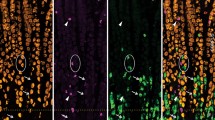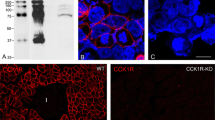Summary
Enterochromaffin cells of adult mouse duodenum were studied with light- and electron-microscopical techniques. They were distinguished from other enteroendocrine cells by their pleomorphic, electron-dense secretory granules in the basal cytoplasm. At the apices of enterochromaffin cells, tufts of short microvilli bordered the gut lumen. At their bases, irregular cytoplasmic extensions were either in contact with or passed through the basal lamina. The presence of cytoplasmic extensions in close proximity to fenestrated capillaries and subepithelial nerves suggested an endocrine or paracrine function. Electron micrographs of serial thin sections were used to reconstruct an enterochromaffin cell from the crypt epithelium in three dimensions and to determine its relationship with the underlying neural plexus. Although extensions from the serially sectioned and reconstructed cell and other enterochromaffin cells studied in crypt epithelia protruded through the basal lamina, no synaptic contacts were seen. Evidence of a synaptic contact between a neurite and another type of enteroendocrine cell (possibly an intestinal A cell), suggested a neurocrine role for some of the basally-granulated cells. Possible functions of enterochromaffin cells are discussed in the light of recent literature on the system of enteroendocrine cells, also known as APUD (amine precursor uptake and decarboxylation) cells and/or paraneurons.
Similar content being viewed by others
References
Alumets J, Håkanson R, Sundler R, Chang KJ (1978) Leu-enkephalin-like material in nerves and enterochromaffin cells in the gut. An immunohistochemical study. Histochemistry 56:187–196
Burks TF, Long JP (1966) 5-Hydroxytryptamine release into dog intestinal vasculature. Am J Physiol 211:619–625
Campenhout E van (1953) Les cellules argentaffines de l'appendice ileó-caecal de l'embryon humain. Bull Acad Roy Med Belg 18:160–183
Ciaccio C (1907) Sopra speciali cellule granulose delia mucosa intestinale. Arch Ital Anat Embryol 6:482–498
Cooke HJ, Montakhab M, Wade PR, Wood JD (1983) Transmural fluxes of 5-hydroxytryptamine in guinea pig ileum. Am J Physiol 244:G421-G425
Feher E (1976) Ultrastructural study of nerve terminals in the submucous plexus and mucous membrane after extirpation of the myenteric plexus. Acta Anat 94:78–88
Ferreira MN (1971) Argentaffin and other “endocrine” cells of the small intestine in the adult mouse. Am J Anat 131:315–330
Forssmann WG, Orci L, Pictet R, Renold AE, Rouiller C (1969) The endocrine cells in the epithelium of the gastrointestinal mucosa of the rat. J Cell Biol 40:692–715
Fujita T (1976) The gastro-enteric endocrine cell and its paraneuronic nature. In: Coupland R, Fujita T (eds) Chromaffin, enterochromaffin and related cells. Elsevier, New York, pp 191–208
Gershon MD, Dreyfus CF, Pickel VM, John TH, Reis DJ (1977) Serotonergic neurons in the peripheral nervous system: identification in gut by immuno-chemical localization of tryptophan hydroxylase. Proc Natl Acad Sci (USA) 71:3086–3089
Heitz P, Polak JM, Timson CM, Pearse AGE (1976) Enterochromaffin cells as the endocrine source of gastrointestinal Substance P. Histochemistry 49:343–347
Heitz P, Kasper M, Krey G, Polak JM, Pearse AGE (1978) Immunoelectron cytochemical localization of motilin in human duodenal enterochromaffin cells. Gastroenterology 74:713–717
Hohenleitner F, Tansy M, Golder R (1971) Effect of vagal stimulation on duodenal serotonin in the guinea-pig. J Pharm Sci 60:471–472
Huber JD, Parker F, Odland GF (1968) A basic fuchsin and alkalinized methylene blue rapid stain for epoxy-embedded tissues. Stain Technol 43:83–87
Katayama Y, North RA, Williams JT (1979) The action of substance P on neurons of the myenteric plexus of the guinea-pig small intestine. Proc R Soc Lond B 206:191–208
Larsson L-I (1980) On the possible existence of multiple endocrine, paracrine and neurocrine messengers in secretory cell systems. Invest Cell Pathol 3:73–86
Lundberg JM, Dahlstrom A, Bylock A, Ahlman H, Pettersson G, Larsson I, Hansson H, Kewenter J (1978) Ultrastructural evidence for an innervation of epithelial enterochromaffin cells in the guinea-pig duodenum. Acta Physiol Scand 104:3–12
Masson P (1914) La glande endocrine de l'intestin chez l'homme. CRS Acad Sci Paris 158:59–61
Newson B, Ahlman H, Dahlstrom A, Das Gupta T, Nyhus L (1979) On the innervation of the ileal mucosa in the rat ⊕ synapse. Acta Physiol Scand 105:387–389
North RA, Henderson A, Katayama Y, Johnson SM (1980) Electrophysiological evidence of presynaptic inhibition of acetylcholine release by 5-hydroxy-tryptamine in the enteric nervous system. Neuroscience 5:581–586
Osaka M, Kobayashi S (1976) Duodenal basal-granulated cells in the human fetus with special reference to their relationship to nervous elements. In: Fujita T (ed) Endocrine gut and pancreas. Elsevier, New York, pp 145–158
Page IH (1968) Serotonin. Year Book Medical Publishers, Chicago
Pearse AGE, Polak JM (1975) Immunocytochemical localization of Substance P in mammalian intestine. Histochemistry 41:373–375
Pettersson G (1979) The neural control of the serotonin content in mammalian enterochromaffin cells. Acta Physiol Scand Suppl 470:1–30
Rubin W, Gershon MD, Ross LL (1971) Electron microscope radioautographic identification of serotonin-synthesizing cells in the mouse gastric mucosa. J Cell Biol 50:399–415
Sato T (1968) A modified method for lead staining of thin sections. J Electr Microsc (Tokyo) 17:158–159
Simard L-C (1934) Sur les relations des cellules argentaffines de l'intestin avec les nerfs chez l'embryon de veau. Arch Anat Microsc 30:235–248
Solcia E, Capella C, Buffa R, Fiocca R, Frigerio B, Usellini L (1980) Identification, ultrastructure and classification of gut endocrine cells and related growths. Invest Cell Pathol 3:37–50
Solcia E, Creutzfeldt W, Falkmer S, Fujita T, Greider M, Grossman M, Grube D, Hakanson R, Larsson L-I, Lechago J, Lewin K, Polak JM, Rubin W (1981) Human gastroenteropancreatic endocrine-paracrine cells: Santa Monica 1980 classification. In: Cellular basis of chemical messengers in the digestive system. UCLA Forum Med Sci 23:159–165
Sundler F, Håkanson R, Loren I, Lundquist I (1980) Amine storage and function in peptide hormone-producing cells. Invest Cell Pathol 3:87–104
Vassallo G, Capella C, Solcia E (1971) Grimelius' silver stain for endocrine cell granules, as shown by electron microscopy. Stain Technol 46:7–13
Wade PR, Cooke HJ, Wood JD (1982) Transmural movement of serotonin in guinea pig ileum. Fed Proc 41:1744
Wood JD (1981) Synaptic interactions in the enteric plexuses. J. Auton Nerv Syst 4:121–133
Author information
Authors and Affiliations
Rights and permissions
About this article
Cite this article
Wade, P.R., Westfall, J.A. Ultrastructure of enterochromaffin cells and associated neural and vascular elements in the mouse duodenum. Cell Tissue Res. 241, 557–563 (1985). https://doi.org/10.1007/BF00214576
Accepted:
Issue Date:
DOI: https://doi.org/10.1007/BF00214576




